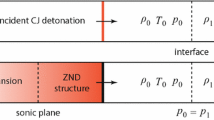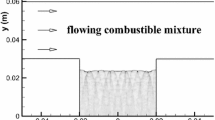Abstract
A semi-analytical model is presented for predicting the trajectory of the transverse detonation during the re-initiation process of a diffracted cellular detonation wave from a channel. Numerical simulations based on the two-dimensional reactive Euler equations with a detailed hydrogen/oxygen chemistry model were first performed to observe key characteristics of cellular detonation wave diffraction and to obtain required input parameters for the model construction. The present numerical observations indicate that the transverse detonation stems from a location on the expansion wave front, and the horizontal distance from this initial location to the channel exit can be scaled by a constant multiplied by the detonation cell width for large deviation angles of the channel. The velocity of the transverse detonation basically equals the Chapman–Jouguet detonation wave velocity consisting of two orthogonal components: the expansion velocity of the diffracted wave front and the relative velocity to the diffracted wave front. The shape of the decoupled wave front is not affected by local explosion and thus can be predicted by the Chester–Chisnell–Whitham theory. Based on these numerical observations and the Chester–Chisnell–Whitham theory, a semi-analytical model is constructed to predict the wave trajectories as well as the distances of the wall reflection point for various deviation angles and initial pressures. The model prediction agrees with the corresponding numerical results. The model result shows that the distance of the wall reflection point varies from 15 to 20 multiples of the cell width with a minimal dependence on deviation angle, independent of the initial pressure. The trajectory calculated by the model is self-similar and determined by the horizontal distance of the initial location. The dimensionless trajectories divided by the horizontal distance are coincident for different initial pressures.




















Similar content being viewed by others
References
Zeldovich, Y.B.: An experimental investigation of spherical detonation of gases. Sov. Phys. Tech. Phys. 1, 1689–1713 (1956)
Edwards, D., Thomas, G., Nettleton, M.: The diffraction of a planar detonation wave at an abrupt area change. J. Fluid Mech. 95(1), 79–96 (1979). https://doi.org/10.1017/S002211207900135X
Mitrovanov, V.: The diffraction of multifront detonation waves. Sov. Phys. Dokl. 9, 1055 (1964)
Knystautas, R., Lee, J., Guirao, C.: The critical tube diameter for detonation failure in hydrocarbon–air mixtures. Combust. Flame 48, 63–83 (1982). https://doi.org/10.1016/0010-2180(82)90116-X
Murray, S., Lee, J.: On the transformation of planar detonation to cylindrical detonation. Combust. Flame 52, 269–289 (1983). https://doi.org/10.1016/0010-2180(83)90138-4
Arienti, M., Shepherd, J.: A numerical study of detonation diffraction. J. Fluid Mech. 529, 117–146 (2005). https://doi.org/10.1017/S0022112005003319
Pintgen, F., Shepherd, J.: Detonation diffraction in gases. Combust. Flame 156(3), 665–677 (2009). https://doi.org/10.1016/j.combustflame.2008.09.008
Gallier, S., Le Palud, F., Pintgen, F., Mével, R., Shepherd, J.: Detonation wave diffraction in H\(_2\)–O\(_2\)–Ar mixtures. Proc. Combust. Inst. 36(2), 2781–2789 (2017). https://doi.org/10.1016/j.proci.2016.06.090
Lee, J.H.S.: The Detonation Phenomenon. Cambridge University Press, Cambridge (2008). https://doi.org/10.1017/CBO9780511754708
Mehrjoo, N., Zhang, B., Portaro, R., Ng, H., Lee, J.: Response of critical tube diameter phenomenon to small perturbations for gaseous detonations. Shock Waves 24(2), 219–229 (2014). https://doi.org/10.1007/s00193-013-0491-2
Mehrjoo, N., Gao, Y., Kiyanda, C.B., Ng, H.D., Lee, J.H.: Effects of porous walled tubes on detonation transmission into unconfined space. Proc. Combust. Inst. 35(2), 1981–1987 (2015). https://doi.org/10.1016/j.proci.2014.06.031
Xu, H., Mi, X., Kiyanda, C.B., Ng, H.D., Lee, J.H., Yao, C.: The role of cellular instability on the critical tube diameter problem for unstable gaseous detonations. Proc. Combust. Inst. 37(3), 3545–3553 (2019). https://doi.org/10.1016/j.proci.2018.05.133
Whitham, G.: A new approach to problems of shock dynamics Part I Two-dimensional problems. J. Fluid Mech. 2(2), 145–171 (1957). https://doi.org/10.1017/S002211205700004X
Bartlmä, F., Schröder, K.: The diffraction of a plane detonation wave at a convex corner. Combust. Flame 66(3), 237–248 (1986). https://doi.org/10.1016/0010-2180(86)90137-9
Thomas, G., Edwards, D., Lee, J., Knystautas, R., Moen, I., Wei, Y.: Detonation diffraction by divergent channels. Dyn. Explos. Prog. Astronaut. Aeronaut. 106, 144–154 (1986). https://doi.org/10.2514/5.9781600865800.0144.0154
Khasainov, B., Presles, H.N., Desbordes, D., Demontis, P., Vidal, P.: Detonation diffraction from circular tubes to cones. Shock Waves 14(3), 187–192 (2005). https://doi.org/10.1007/s00193-005-0262-9
Nagura, Y., Kasahara, J., Sugiyama, Y., Matsuo, A.: Comprehensive visualization of detonation–diffraction structures and sizes in unstable and stable mixtures. Proc. Combust. Inst. 34(2), 1949–1956 (2013). https://doi.org/10.1016/j.proci.2012.07.078
Nagura, Y., Kasahara, J., Matsuo, A.: Multi-frame visualization for detonation wave diffraction. Shock Waves 26(5), 645–656 (2016). https://doi.org/10.1007/s00193-016-0663-y
Kasahara, J., Kawasaki, A.: Critical condition for detonation diffraction with stable and unstable mixtures. 26th International Colloquium on the Dynamics of Explosions and Reactive Systems, Boston, MA, Paper 963 (2017)
Deiterding, R.: Parallel adaptive simulation of multi-dimensional detonation structures. PhD Thesis, Brandenburgischen Technischen Universität Cottbus, Germany (2003)
Deiterding, R.: A parallel adaptive method for simulating shock-induced combustion with detailed chemical kinetics in complex domains. Comput. Struct. 87(11), 769–783 (2009). https://doi.org/10.1016/j.compstruc.2008.11.007
Berger, M.J.: Adaptive mesh refinement for hyperbolic partial differential equations. PhD Thesis, Stanford University, California (1982)
Yuan, X., Zhou, J., Lin, Z., Cai, X.: Adaptive simulations of detonation propagation in 90-degree bent tubes. Int. J. Hydrog. Energy 41(40), 18,259–18,272 (2016). https://doi.org/10.1016/j.ijhydene.2016.07.130
Yuan, X., Zhou, J., Lin, Z., Cai, X.: Numerical study of detonation diffraction through 90-degree curved channels to expansion area. Int. J. Hydrog. Energy 42(10), 7045–7059 (2017). https://doi.org/10.1016/j.ijhydene.2017.01.206
Cai, X., Deiterding, R., Liang, J., Sun, M., Mahmoudi, Y.: Diffusion and mixing effects in hot jet initiation and propagation of hydrogen detonations. J. Fluid Mech. 836, 324–351 (2018). https://doi.org/10.1017/jfm.2017.770
Miao, S., Zhou, J., Lin, Z., Cai, X., Liu, S.: Numerical study on thermodynamic efficiency and stability of oblique detonation waves. AIAA J. 56(8), 3112–3122 (2018). https://doi.org/10.2514/1.J056887
Peng, H., Huang, Y., Deiterding, R., Luan, Z., Xing, F., You, Y.: Effects of jet in crossflow on flame acceleration and deflagration to detonation transition in methane–oxygen mixture. Combust. Flame 198, 69–80 (2018). https://doi.org/10.1016/j.combustflame.2018.08.023
Yuan, X., Zhou, J., Mi, X., Ng, H.D.: Numerical study of cellular detonation wave reflection over a cylindrical concave wedge. Combust. Flame 202, 179–194 (2019). https://doi.org/10.1016/j.combustflame.2019.01.018
Hairer, E., Wanner, G.: Solving Ordinary Differential Equations II. Stiff and Differential-Algebraic Problems, vol. 14. Springer, Berlin (1991). https://doi.org/10.1007/978-3-662-09947-6
Westbrook, C.K.: Chemical kinetics of hydrocarbon oxidation in gaseous detonations. Combust. Flame 46, 191–210 (1982). https://doi.org/10.1016/0010-2180(82)90015-3
Taylor, B., Kessler, D., Gamezo, V., Oran, E.: Numerical simulations of hydrogen detonations with detailed chemical kinetics. Proc. Combust. Inst. 34(2), 2009–2016 (2013). https://doi.org/10.1016/j.proci.2012.05.045
Shi, L., Shen, H., Zhang, P., Zhang, D., Wen, C.: Assessment of vibrational non-equilibrium effect on detonation cell size. Combust. Sci. Technol. 189(5), 841–853 (2017). https://doi.org/10.1080/00102202.2016.1260561
Smirnov, N., Betelin, V., Shagaliev, R., Nikitin, V., Belyakov, I., Deryuguin, Y.N., Aksenov, S., Korchazhkin, D.: Hydrogen fuel rocket engines simulation using LOGOS code. Int. J. Hydrog. Energy 39(20), 10748–10756 (2014). https://doi.org/10.1016/j.ijhydene.2014.04.150
Smirnov, N., Betelin, V., Nikitin, V., Stamov, L., Altoukhov, D.: Accumulation of errors in numerical simulations of chemically reacting gas dynamics. Acta Astronaut. 117, 338–355 (2015). https://doi.org/10.1016/j.actaastro.2015.08.013
Chester, W.: CXLV. The quasi-cylindrical shock tube. Lond. Edinb. Dublin Philos. Mag. J. Sci. 45(371), 1293–1301 (1954). https://doi.org/10.1080/14786441208561138
Chisnell, R.: The motion of a shock wave in a channel, with applications to cylindrical and spherical shock waves. J. Fluid Mech. 2(3), 286–298 (1957). https://doi.org/10.1017/S0022112057000130
Skews, B.W.: The shape of a diffracting shock wave. J. Fluid Mech. 29(2), 297–304 (1967). https://doi.org/10.1017/S0022112067000825
Best, J.: A generalisation of the theory of geometrical shock dynamics. Shock Waves 1(4), 251–273 (1991). https://doi.org/10.1007/BF01418882
Li, H., Ben-Dor, G.: A modified CCW theory for detonation waves. Combust. Flame 113(1–2), 1–12 (1998). https://doi.org/10.1016/S0010-2180(97)00136-3
Ridoux, J., Lardjane, N., Monasse, L., Coulouvrat, F.: Comparison of geometrical shock dynamics and kinematic models for shock-wave propagation. Shock Waves 28(2), 401–416 (2018). https://doi.org/10.1007/s00193-017-0748-2
Peace, J., Lu, F.: On the propagation of decaying planar shock and blast waves through non-uniform channels. Shock Waves (2018). https://doi.org/10.1007/s00193-018-0818-0
Ridoux, J., Lardjane, N., Monasse, L., Coulouvrat, F.: Beyond the limitation of geometrical shock dynamics for diffraction over wedges. Shock Waves (2019). https://doi.org/10.1007/s00193-018-00885-w
Nettleton, M.: Shock attenuation in a ‘gradual’ area expansion. J. Fluid Mech. 60(2), 209–223 (1973). https://doi.org/10.1017/S0022112073000121
Sloan, S., Nettleton, M.: A model for the axial decay of a shock wave in a large abrupt area change. J. Fluid Mech. 71(4), 769–784 (1975). https://doi.org/10.1017/S0022112075002844
Sloan, S., Nettleton, M.: A model for the decay of a wall shock in a large abrupt area change. J. Fluid Mech. 88(2), 259–272 (1978). https://doi.org/10.1017/S0022112078002098
Acknowledgements
This work is supported by the National Natural Science Foundation of China under Grant Nos. 91441201 and 51776220 and the Natural Sciences and Engineering Research Council of Canada (NSERC). The authors thank A. J. Higgins and the anonymous reviewers whose comments have greatly improved the quality of this manuscript.
Author information
Authors and Affiliations
Corresponding author
Additional information
Communicated by N. Smirnov.
Publisher's Note
Springer Nature remains neutral with regard to jurisdictional claims in published maps and institutional affiliations.
Rights and permissions
About this article
Cite this article
Yuan, X.Q., Mi, X.C., Ng, H.D. et al. A model for the trajectory of the transverse detonation resulting from re-initiation of a diffracted detonation. Shock Waves 30, 13–27 (2020). https://doi.org/10.1007/s00193-019-00904-4
Received:
Revised:
Accepted:
Published:
Issue Date:
DOI: https://doi.org/10.1007/s00193-019-00904-4




